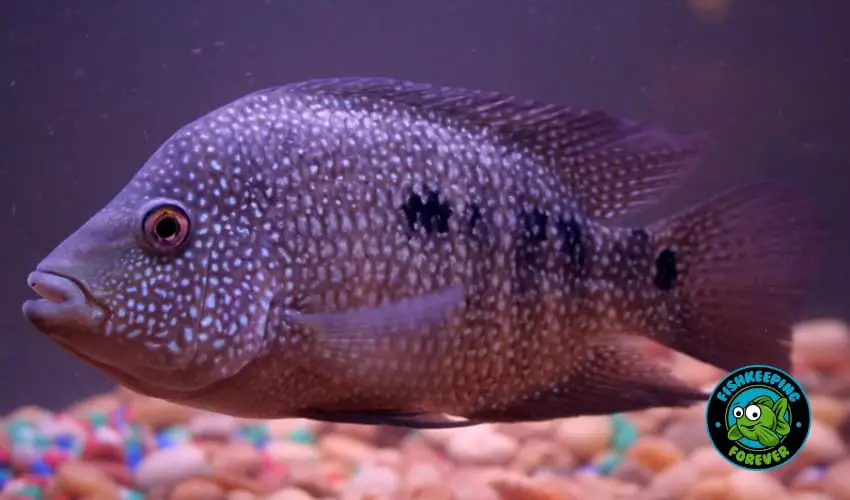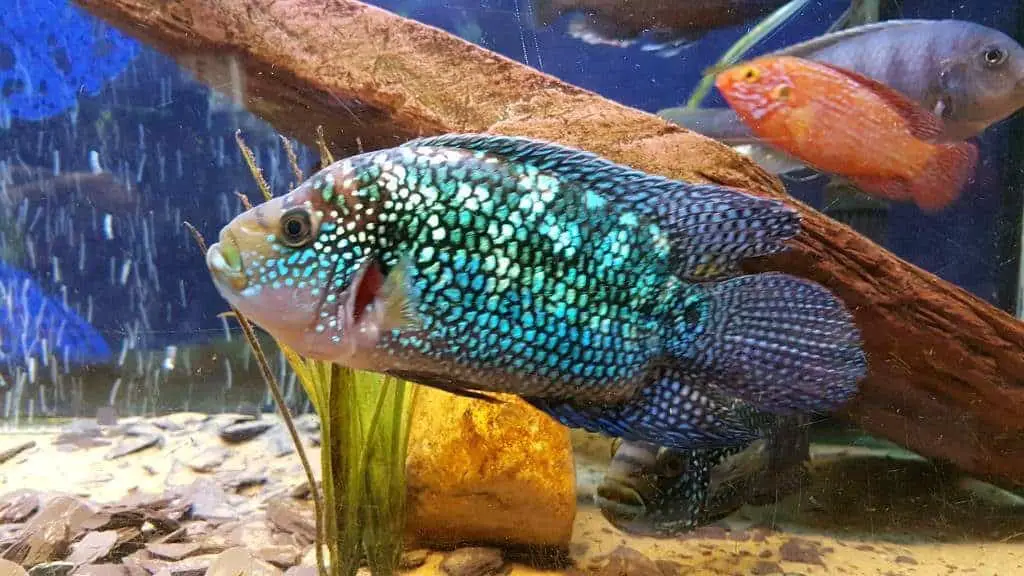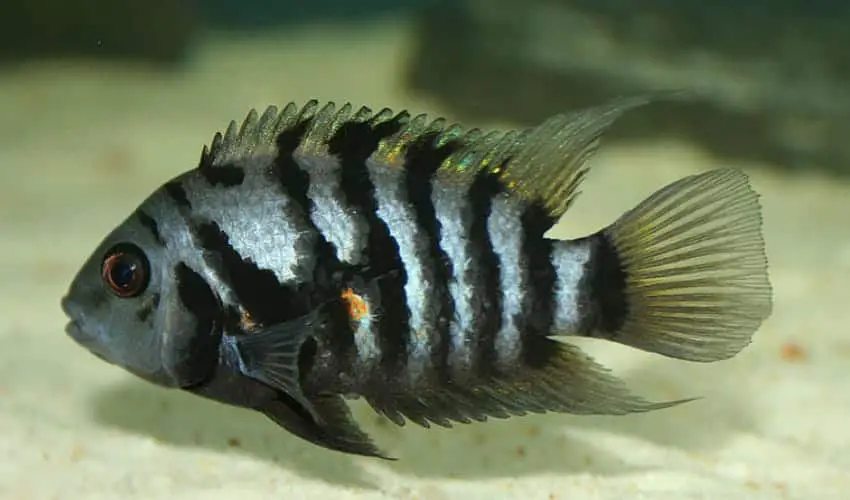The Central American Cichlids are the most popular fish in America. Having flown in from all parts of the world, these fish come from various different environments. From the volcanic lakes to the new river streams which were not present before, the Cichlids are not uncommon in the American waters. They swim in the fast flowing rivers as well and can be caught on the river beds. These cichlids have adapted to the artificial waters with ease because they are so used to human interaction.
The most popular Central American cichlids can now be seen in home aquariums too. You need to understand the environment in which to keep these fish so that they can live a long and healthy life. It is better to provide them with a stable pH and hardness. You should not put them in constantly changing conditions as this can disturb their growth. It is okay if you cannot achieve the ideal level that is required by the cichlids.
Among the different types of cichlids present in Central America, the five most popular ones are the Firemouth, Texan, Tiger Oscar, Jack Dempsey, and Convict Cichlid. They are described below in detail:
Table of Contents
Firemouth cichlid

| Common Name | Firemouth Cichlid |
|---|---|
| Scientific Name | Thorichthys meeki |
| Family | Cichlidae |
| Care level | easy-moderate |
| Temperament | Semi-Aggressive |
| Diet | Omnivore |
| Ideal Foods | Cichlid pellets, Flakes and live foods |
| Water Conditions | 72-81° F, KH 4-10, pH 6.0-7.5 |
| Tank size | 50 Gallons+ |
| Max Size | 7-8" |
| Aquarium Decor | Well planted, rocks,caves and driftwood |
| Jumpers? | Only when first introduced to the aquarium or if being bullied by larger fish |
| Breeding | Easy, mouthbrooders |
| Cost | $7+ |
The Firemouth Cichlid is the most different among all these types of fish. It can live in waters with pH levels as low as 6.5. They have a more forgiving nature and are built to survive. Their survival skills allow them to live in temperatures of about 75 degrees Fahrenheit and above. These fish come from the Yucatan Peninsula of Mexico, Belize, and northern Guatemala.
They are river fish and like slow-moving waters which is why they can easily be kept in aquariums. You might have seen these fish in their orange and red hues. They can grow up to 6 inches and if compared to other fish, they are only moderately aggressive. They form exclusive pairs and brood on flat sides like rocks or submerged wood and are productive breeders with a lone spawn in the range of 100-500 eggs. Although you can keep them with other fish, they happily like to live with their own kind.
In smaller tanks, they can harass and kill especially when they are about to mate. These cichlids are used to eating a variety of different things.
Ranging from vegetables to meat, they can get used to whatever you feed them on a daily basis. Just make sure you give them something you can afford at breeding time, because once they are familiar with something special, they don’t like to eat anything else.
Read our complete Firemouth Care and Buyers Guide
Texan Cichlid

| Scientific Name | Herichthys cynoguttatus |
|---|---|
| Common Names | Rio Grande Perch, Rio Grande Cichlid |
| Family | Cichlidae |
| Temperament | Aggressive |
| Care Level | Difficult |
| Diet | Omnivore |
| Origin | Captive bred,Northern Mexico, Texas |
| Size | 12” Max |
| Aquarium Size | 50 Gal + |
| Cost | $8 |
The Texan Cichlid (also knows as the Rio Grande Cichlid) is the only species which is native to the United States. It is found in the drainage basins of Texas and Northern Mexico. Because of its specialized location, the Texan Cichlid has some properties which are special to it. It can grow to around 13 inches in size. It has turquoise skin which makes it very beautiful to look at.
However, as charming as they look, they are one of the most dangerous fish you will find. They have high levels of aggressiveness and are one of the most dangerous fish in the waters. If you mess with them they will protect themselves no matter what. It is wise not to keep the Texan Cichlid with other types of fish because it can end in death.
However, individuals also say that if these fish get familiar with having a partner, they can live with them in peace. We highly recommend a big tank for them especially if you want to breed these fish. They can attack and damage aquarium equipment. They also dig out the plants in the aquarium so be very careful in selecting what you want to put up.
It’s not worth spending a lot of money on creating a stylish aquarium because you may well have to change it every now and then, due to their tendency to re-arrange all the décor you carefully choose for them. Be smart when you are dealing with the Texan Cichlid.
Tiger Oscar

| Scientific Name | Astronotus ocellatus |
|---|---|
| Family | Cichlidae |
| Temperament | Semi-aggressive |
| Care Level | Difficult |
| Color | Black, Orange, Red |
| Diet | Carnivore |
| Size | 1" |
| Origin | Amazon, South America |
| price | $5-8 |
The Tiger Oscar is commonly known as the Oscar fish (Astronotus ocellatus). It belongs to the cichlids family as it originates from South America. A large and dramatically colored, handsome fish, they quickly grow to up to 12 inches in length. In South America, the Tiger Oscar can be seen for sale in the local markets due to its rich taste making it a highly valued food.
A popular aquarium fish, they are graceful swimmers and command the attention of those observing them. Being relatively easy to keep, they make an ideal beginner fish however, due to their rapid growth, they’ll need a tank of at least 100 gallons.
As a large fish, the Tiger Oscar is predatory and is known to eat other fish in their environment. However, they are a curious and playful species, enjoying rearranging their surroundings and will even play with ‘toys’; they will also investigate what is going on outside their tank.
A carnivorous fish, the Tiger Oscar prefer a variety of live, meaty foods but will happily consume anything you give them in the way of pellet, dead, frozen etc. As they grow larger high-quality pelleted foods and large, chunky foods such as cut up worms are recommended. They need several feedings throughout the day!
No matter what you give them they will consume it. You need to keep these fish in a big tank because they are likely to injure other fish. During the mating period keep a close eye on the pair as they are quite impulsive and can do a lot of damage to the aquarium. If you think they are not comfortable with one mate, try adding a new one but not during the mating period. They need time to get familiar to the new mate before breeding.
Read our Tiger Oscar Complete Care Guide
Jack Dempsey

| Scientific Name | Rocio octofasciatum |
|---|---|
| Family | Cichlidae |
| Origin | Farm Raised,Central America |
| Diet | Carnivore |
| Temperament | Aggressive |
| Care Level | Easy |
| Color | Black, Blue, Clear, Green, Tan |
| Tank Size | 50 Gallons Plus |
| Price | $5 |
As the name suggests the Jack Dempsey cichlid (Rocio octofasciata) gets its name from the heavyweight boxing champion of the 1920’s due to its heavy-set looks, strong facial features and aggressive tendencies.
If keeping them in an aquarium, they need a tank size of at least 55 gallons with a fine sandy substrate and due to its ‘shy’ but territorial nature it will need lots of rocky and cave areas in which to hide as well as a plentiful amount of plants and some drift-wood.
Growing to a size of 10 inches, they are strikingly colorful with black, blue, green and clear being the dominant colors; coloring changes at various times, notably when they are under stress and during breeding times.
Whilst it is agreed that it’s difficult to tell which are male and female, generally speaking, the female Jack Dempsey is smaller with less vibrant colors than the male. Both parents incubate the eggs which are laid on flat, hard surfaces such as rocks. Once hatched the parents transfer their fry to a pit that they dig, and defend them from all tank-mates – this is a time when the adults can become particularly aggressive.
Considered a predator, Jack Dempsey is classed as carnivorous and their feeding in the home aquarium is relatively easy. They will eat most foods, including live brine-shrimp, blood worm and tubifex as well as pellets, freeze-dried and finely chopped up green leaves.
A territorial and sometimes aggressive fish, Jack Dempsey are relatively easy to keep in a home aquarium, show good parental care to their young, have a wonderful coloring and eat just about anything you feed them!
Read our complete Jack Dempsey Care Guide
Convict Cichlid

| Scientific Name | Archocentrus nigrofasciatus |
|---|---|
| Common Names | Zebra Cichlid or Black Convict Cichlid |
| Family Name | Cichlidae |
| Origin | Captive Raised |
| Temperament | Aggressive |
| Care Level | Moderate |
| Diet | Omnivore |
| Max Size | 5.5-6" |
| Color | Black and silver |
| Cost | $6 |
Depending on the gender of the Convict Cichlid (Amatitlania nigrofasciata), also known as the Zebra Cichlid due to their zebra-like markings, they grow to between four to six and a half inches. The females are usually the smaller of the species. In most American homes, the convict cichlid is the most popular fish in an aquarium. It is easy to take care of and maintain. These fish do not require a large area in comparison to other types, a tank of 30 gallons is suitable.
The fish have dark stripes on their bodies which explains their name as they look like striped prison uniforms; unusual in the fish kingdom, it is the female which carries the more colorful appearance. Although they are not very aggressive in nature, they do know how to protect themselves, which they do by chasing, biting and harassing other fish which have come too close to their home or eggs/fry. They also tease other big fish to get them to act aggressively. In fact, they can cause trouble in smaller aquariums.
Being cave breeders, the Convict Cichlid prefers a tank which has lots of big rocks and cover. Like some other types, the convict cichlid also eats a variety of different things and are best fed 2-3 times a day. Typical food includes insects, crustaceans, worms, algae and plants as well as high-quality flakes and pellets. If you want to keep something nice and small in your home, you will find this fish most suitable.
Maturity occurs at about the age of 6 months and form monogamous pairs, spawning in small caves and crevices. Both parents care for their young up to them being 4-6 weeks old as fry. The fry will forage for food during daylight and return ‘home’ as it becomes darker; the parents will often sweep up the fry in their mouths in order to return all the juveniles safely back in the nest before dark.
A hardy fish, the Convict Cichlid is easy to care for, a fish which breeds readily and which cares for its young diligently, making this an ideal fish for a beginners aquarium as well as those interesting in breeding the species. Requirements are minimal as due to the size of the fish, they don’t need a large aquarium – 30 gallons being the norm – feeding is relatively simple and breeding is almost guaranteed!!
Conclusion
Keeping fish at home is a true pleasure. Depending on your own particular needs and wants, you can choose any one of these Cichlids and keep it in your home aquarium. The Central American cichlids are pretty creatures which are also smart. These fish are easy to maintain and breed in the long run. They are excellent parents and protect their young ones. The different types include some small ones which are peace loving and some big ones which are rather aggressive.
Make sure you identify the aggressive ones before you put them together with other fish as they can prove to be dangerous. Always select the aquarium after you have decided on which fish you are going to buy because aquarium damages can lead to a lot of monetary loss which you cannot anticipate beforehand.
The Top 5 Central American Cichlids are certainly a good place to start if you’re thinking of keeping cichlids. Whichever one you choose we hope you love it as much as we have over the years.
Good luck and let us know how you get on. Don’t forget to join our friendly Facebook fish group and subscribe to our Youtube channel.

I have been working in the tropical fish industry for over 30 years now and I’m still learning. Everyday is a school day in this hobby. In my spare time I play golf very badly!


